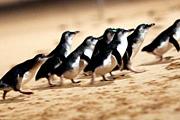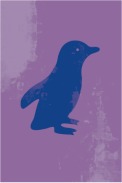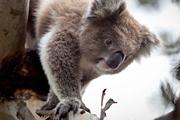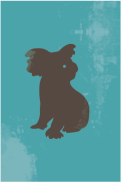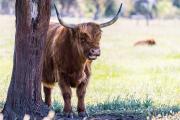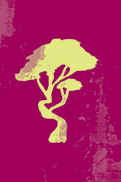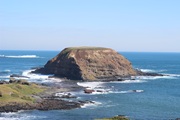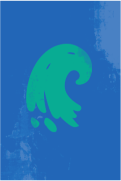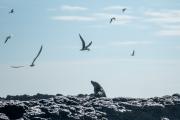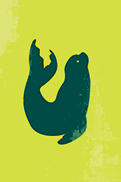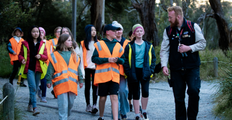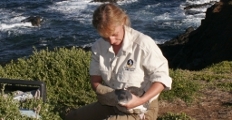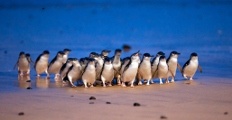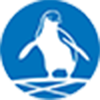A quick guide to hooded plovers
The hooded plover, also known as the hooded dotterel, is a medium-sized shorebird that’s native to south-eastern Australia. They have a unique appearance thanks to their black ‘hood’, white nape, black hind neck, white under parts, black tipped red beak and red eye ring.
On Phillip Island (Milawul), hooded plovers are seen along southern and western shorelines and more isolated bay beaches on the northern side. They forage on the sand, along the waterline and on intertidal rock platforms. Hooded plovers often like nesting with the indigenous plant hairy spinifex, and can also be seen sheltering on the beach behind clumps of seaweed.
What do hooded plovers eat?
Hooded plovers feed by sight using their large eyes and short bills. They are opportunistic feeders, often seen running along the tide wrack in search of food.
They eat a variety of invertebrates, such as amphipod crustaceans, molluscs, insects and polychaete worms, as well as plant material including seeds and turions.
The circle of life for hooded plovers
Clutches of one to three fawn and brown speckled eggs are laid from August to March, with the peak laying period in January. On Phillip Island, nest sites can be classified into three types based on geomorphology: stony terrace, primary dune and flat beach. Nests are located above average high tide levels and are usually a depression ‘scrape’ in the sand and when on stony terraces they are often lined with light coloured grit or seaweed.
As pairs defend a territory from other birds, there are usually only one or two nesting pairs per beach. Both parents share incubation for about 28 days and when the eggs hatch, the parents teach the chicks to feed and to quickly find shelter in beach vegetation or tidewrack. Hooded plover chicks must feed themselves from day one but will stay with their parents until they leave the nest after about 35 days, but sometimes they stay around with mum and dad much longer!
Are hooded plovers endangered?
With only around 3,000 hooded plovers left in south-eastern Australia, they’re listed as vulnerable in Victoria and South Australia, and critically endangered in New South Wales.
Unfortunately, the breeding success of hooded plovers is extremely low due to the high-risk areas that they breed in. Sixty percent of chicks are lost before leaving their nests, with nests being difficult to see and easily damaged or disturbed by beachgoers.
Hooded plovers are also easily entangled in fishing line and other rubbish left on beaches. Natural forces including high tides, storms, windblown sand and temperature extremes also affect their survival. Introduced predators such as foxes, dogs, feral cats and rodents, as well as natural predators including raptors, gulls, ravens and magpies, take not only the hooded plover adults, but also chicks and eggs.
There are three ways hooded plovers help avoid threats:
-
Camouflage: Parents provide shelter for eggs and chicks with their bodies and wings and often sit very still to avoid detection. The eggs and chicks colouring also blends in with their natural environment.
-
Distraction: If surprised by walkers and/or dogs, the parents will call and perform distraction displays such as feigning a broken wing, to both warn chicks and distract predators. Hooded plover chicks bob down immediately or seek shelter, leaving them open to exposure, predation or crushing. Constant disturbance will waste all their valuable energy, putting them further at risk.
-
Fleeing: Parent birds will call to their chicks to hide or lead them away from approaching danger.
Protecting the hooded plover on Phillip Island
Phillip Island Nature Parks, along with local conservation groups and volunteers have been monitoring the hooded plover population since the 1980s. Recent plans have focused on increasing breeding success and adult survival.
The strategies include:
-
Fencing off breeding beaches from wandering sheep and cattle.
-
Controlling pest plants and animals especially foxes, dogs and cats.
-
Enforcing regulations prohibiting dogs and horses on breeding beaches.
-
Public Education Programs. Volunteers are involved in the ‘Hooded Plover Watch’ program and ranger’s patrol beaches during the breeding season.
-
Erecting temporary fencing and signage around vulnerable nests to create refuges
-
Interpretive signage and school visits
-
Population monitoring through nest records and leg banding of chicks
-
Online data portal through Birdlife Australia.
-
Phillip Island is probably one of the few places where hooded plover numbers are increasing thanks to research, intensive management and public support.
What you can do to help the hooded plover
-
Read signs thoroughly before you enter an area.
-
Don’t take your dog into areas where they aren’t allowed.
-
When walking, keep below the high tide line and watch where you are walking.
-
Keep your dogs and cats in at night and place a collar and bell on them.
-
Stick to designated pathways and boardwalks.
-
Pick up rubbish such as fishing lines and other plastic from the beach and place rubbish in the bin or recycle it.
Hooded plover facts
-
Weight: 90–100g
-
Length: ~200mm
-
Lifespan: Up to 20 years
Download the print-friendly hooded plover guide here.
Visit Phillip Island and explore rugged coastal clifftops where you may just spot the beautiful hooded plover on our shoreline. Book your visit online.





